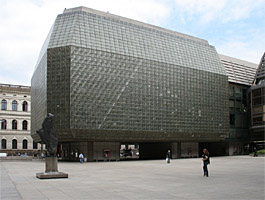
New Scene celebrates 35 years, a reconstruction is planned for the coming years
 |
"In a few weeks, we will announce a tender for the project documentation," said ND director Jan Burian to ČTK today. ND has developed a feasibility study, and once they receive the project documentation, they will search for a general contractor through a tender. Modernization is therefore a matter for the coming years. It will affect theater technologies and access routes for transporting decorations and costumes.
The New Stage, a striking building designed by architect Karel Prager, is an example of the specific use of glass in architecture. Even three decades after its inception, it can stir passions among those who demand heritage protection and respectful preservation of all its elements, and those for whom it symbolizes a bygone era. "The Ministry of Culture recently received a proposal to declare the New Stage a cultural monument; it is now acquiring the necessary materials for its qualified evaluation," said ministry spokesperson Simona Cigánková to ČTK today. The administrative process has not yet been initiated by the office. The building is unusual even in its interior - the dominant material inside is green Cuban serpentine, which was gifted to the then government by Cuba during socialism.
The inaugural performance of the New Stage was Tyl's Strakonický dudák on November 20, 1983. The production was meant to demonstrate the variability of the space in its most radical version, with the hall arranged in an arena style with the stage in the center, and the premiere was broadcast live on television. However, the very first performance highlighted rather the shortcomings of the stage and theater, including poor acoustics. Therefore, discussions about the reconstruction of the New Stage have been ongoing for years.
The question of developing the space between the National Theater and the Ursuline Monastery was addressed during the extensive renovation of the historical theater building from 1977 to 1983. However, architectural competitions for the immediate surroundings of the building had been held decades earlier. A turning point came with the demolition of the Choura (Koura) houses, a large structure on Národní Street in the late 1950s.
In the mid-1970s, plans were made for the construction of an operational building for the theater, a restaurant, and a theater hall for the ND ensembles. The sound insulation of the hall against noise from the heavily trafficked Národní Street was solved with a heavy facade sheath clad in stone plates, in front of which stands a wall made of glass blocks designed by Stanislav Libenský. There are 4,306 of these blocks on the building, each measuring 80 by 60 by 40 centimeters and weighing approximately 40 kilograms.
The repertoire of the New Stage includes productions by the Drama, Opera, Ballet, and Laterna magika ensembles. In addition to presenting contemporary Czech and foreign works by its own ensembles, ND also opens its space to guest productions and organizes two international festivals: Prague Crossroads and Opera Nova.
The English translation is powered by AI tool. Switch to Czech to view the original text source.
0 comments
add comment
Related articles
0
17.06.2025 | Members of the ND will say goodbye to the New Stage this Wednesday before its reconstruction
0
13.01.2025 | ND has announced a tender for the contractor for the general reconstruction of the New Stage
0
23.07.2024 | Prager's New Stage was the most visible result of the reconstruction of the National Theatre
0
23.07.2024 | Baxa and the director of the National Theatre will present the renovation project of the New Stage
0
24.06.2021 | New Scene has been operating since 1983, primarily featuring Laterna Magika.
0
24.06.2021 | New Stage is a cultural monument, and the National Theatre plans its reconstruction
9
27.11.2020 | The ministry has initiated proceedings for the declaration of the New Stage as a monument
0
11.04.2019 | MK considers the potential heritage protection of the New Stage and the clinic
0
22.01.2019 | The government approved an investment program for cultural buildings
0
25.08.2014 | The management of the National Theatre is preparing a competition for the reconstruction of the New Stage
0
27.02.2012 | In May, the reconstruction of the New Stage of the National Theatre will begin
1
16.03.2010 | Anatomy of the New Scene
6
10.09.2009 | Architects can compete for the design of the façade of the New Stage










